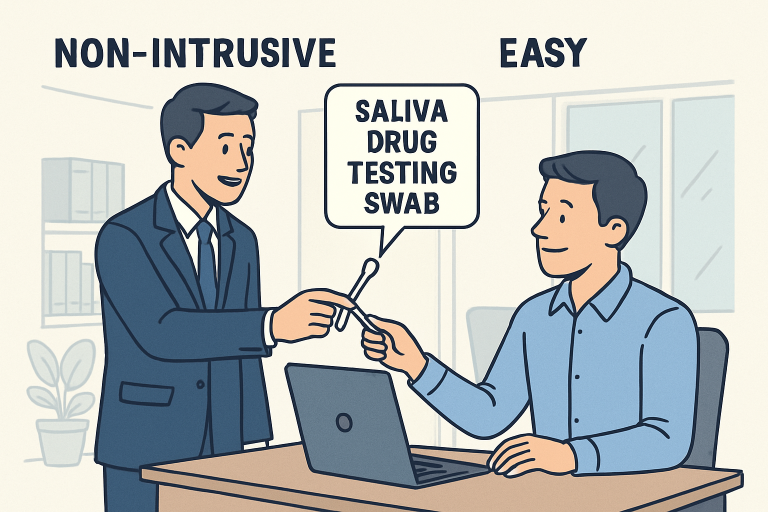Key Takeaways
- Saliva drug testing offers a non-invasive, rapid method for detecting recent drug use.
- It provides a shorter detection window, making it ideal for assessing current impairment.
- Regulatory bodies are increasingly approving saliva testing, enhancing its credibility.
- Implementing saliva testing can improve workplace safety and compliance.
Table of Contents
Introduction
For decades, businesses have relied on urine and hair tests to enforce drug-free policies, but these methods have notable drawbacks, including privacy concerns and slow turnaround times. The advent of saliva drug testing marks a new era in workplace screening—addressing these issues through fast, directly observed sample collection that reduces both employee discomfort and opportunities for adulteration.
This method is also ideal for on-site testing events and day-to-day situations, such as post-incident investigations, where it is crucial to identify recent substance use rather than residual traces that may linger in other biological samples for weeks. Employers seeking to enhance productivity and mitigate risk are increasingly opting for this testing technique due to its unique advantages.
Beyond efficiency, the saliva drug testing kit aligns well with evolving workplace norms around privacy and transparency. As industries face mounting pressure to create more supportive environments, streamlined testing procedures can facilitate the effective management of substance use without fostering distrust or resentment among staff. Modern policy frameworks are beginning to reflect these values, leading to increased acceptance and legal clarity regarding oral fluid testing in many regions.

Advantages of Saliva Drug Testing
Non-Invasive Collection
Saliva drug testing does not require restrooms, special containers, or stringent privacy protocols. This less intrusive process can be administered under direct supervision, reducing the likelihood of tampering or sample substitution and increasing test reliability.
Rapid Results
Results from a saliva-based test are typically available in minutes, which is crucial for time-sensitive scenarios involving workplace incidents or random screenings. According to Medical News Today, mouth swab drug tests are gaining popularity due to their speed, ease of use, and non-invasive nature. HR teams and decision-makers are empowered to act promptly and confidently based on immediate findings.
Detection of Recent Use
Unlike urine or hair tests, which might detect drug use from days or even months prior, saliva tests are more effective at identifying current or very recent drug use, usually within 24 to 48 hours. This makes them ideal for monitoring on-duty impairment and upholding real-time safety protocols.
Reduced Tampering Risk
Because collection is usually observed, manipulation is significantly more difficult. This transparency enables organizations to maintain integrity and reliability in their drug testing programs, thereby reducing the administrative burden associated with retests and disputes.
Regulatory Approvals and Guidelines
An increasing number of regulatory bodies are embracing saliva drug testing, signaling major changes for policy and practice. In June 2023, the United States Department of Transportation (DOT) granted approval for lab-based oral fluid testing of DOT-regulated workers. Implementation awaits certification of the necessary laboratories, signifying an inevitable shift for highly regulated industries such as transportation and logistics.
Compliance is key—employers must stay updated with both federal and state guidelines to avoid litigation or penalties. The progress toward broader acceptance in strict regulatory settings, such as transportation, boosts credibility and confidence in this testing method. For an in-depth look at regulatory developments, Marijuana Moment offers the latest updates on certification milestones and official guidelines. This trend also highlights the growing accuracy and reliability of saliva tests compared to traditional methods. As usage grows, companies can anticipate faster results, more efficient processes, and enhanced workplace safety.
Implementing Saliva Drug Testing in the Workplace
- Policy Development: Review and update drug testing policies to specifically include saliva-based protocols, referencing current regulatory requirements and industry best practices.
- Training: Educate HR professionals, managers, and supervisors on the collection process, proper chain of custody, and procedures for result interpretation. Ongoing training ensures adherence to legal standards and consistent application of policy.
- Vendor Selection: Carefully select partners that offer certified kits and reliable results processing. Establishing clear communication with your vendor ensures the highest level of test integrity and confidentiality.
- Communication: Openly communicate changes to staff, clearly explaining the rationale, benefits, and what employees can expect during the collection process. Address concerns about fairness and privacy to build trust and improve cooperation.
Challenges and Considerations
- Regulatory Compliance: Stay vigilant about changes at both national and local levels. Regulations are evolving rapidly, especially regarding which drugs are tested for and approved methods of collection and analysis.
- Detection Windows: Saliva tests typically identify drugs used within the last 48 hours. Ensure staff and managers understand these limitations so that test results are interpreted appropriately, especially when addressing incidents that may involve earlier substance use.
- Laboratory Certification: As of mid-2024, employers in highly regulated industries must monitor laboratory certification status to ensure its validity. Relying on unapproved labs can lead to disputes or compliance failures, which are integral to program credibility.
Conclusion
Saliva drug testing is set to become a hallmark of modern workplace safety strategies—providing fast, reliable, and dignified screening for recent drug use. As regulatory approvals mount and implementation hurdles are overcome, more organizations will likely adopt these innovative protocols, solidifying their commitment to secure, compliant, and productive work environments.
The Editorial Team at Healthcare Business Today is made up of experienced healthcare writers and editors, led by managing editor Daniel Casciato, who has over 25 years of experience in healthcare journalism. Since 1998, our team has delivered trusted, high-quality health and wellness content across numerous platforms.
Disclaimer: The content on this site is for general informational purposes only and is not intended as medical, legal, or financial advice. No content published here should be construed as a substitute for professional advice, diagnosis, or treatment. Always consult with a qualified healthcare or legal professional regarding your specific needs.
See our full disclaimer for more details.







